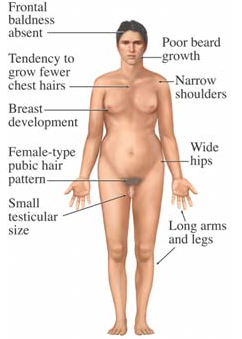Genetic Disorders
Sex Chromosome Number Disorders
There are several chromosomal number disorders that can occur in the sex chromosomes. We will go over some of the most common.
Klinefelter Syndrome
Klinefelter syndrome is caused by the presence of an additional X sex chromosome. For instance, 47XXY. It is caused by maternal meiotic nondisjunction, the incidence of which increases with maternal age. There is no increased risk of reoccurrence: if it happens once, it is not likely to happen again. Rather, it is the same risk of occurrence as in the general population.

Klinefelter syndrome affects 1 in 1,000 newborn boys and is most often undiagnosed preceding puberty. Those with Klinefelter syndrome tend to be taller than average with incomplete musculature, enlarged breasts, small testis, decreased testosterone production, male infertility, and decreased motor skills and dexterity (Figure 1). However, those with Klinefelter Syndrome can usually be sexually active without much issue.
Turner’s Syndrome
Turner’s syndrome is caused by having only one X chromosome (45, X). Like Klinefelter’s syndrome, there is no increased risk of reoccurrence of Turner’s syndrome. Turner’s syndrome may be noted at birth and affects 1 in 2,500 newborn girls.

It results in improper development of the reproductive system, including degeneration of ovaries into fibrous streaks. It also results in a lack of development at puberty, minimal breast bud development, and is the most common cause of primary amenorrhea. Those with Turner’s syndrome often have short heights, a webbed neck, widely separated nipples, a malformation of the aorta, and excess fluid in the extremities resulting from malfunctioning of the lymphatic system.
True Hermaphrodite
True hermaphrodites are quite rare. They result from the fusion of two sperm, one of which carries an X chromosome and the other a Y chromosome. Half of the cells in a true hermaphrodite are XX and the other half are XY. Thus, a true hermaphrodite will have both ovarian and testicular development. Thus, the genitalia of a true hermaphrodite will be ambiguous.
Pseudohermaphrodite
A pseudohermaphrodite will have gonads matching that of their chromosomal sex. However, the external genitalia will not match that of their chromosomal sex. Rather, the external genitalia will match those of the opposite sex.
A male pseudohermaphrodite is an individual who possesses testes as their gonads but has external genitalia that appear female. This condition is often associated with disorders like Androgen Insensitivity Syndrome (AIS) and defective testosterone synthesis. AIS is a genetic condition in which the body is unable to respond to androgens (male sex hormones), resulting in incomplete masculinization of the external genitalia and the development of female secondary sexual characteristics. Defects in testosterone synthesis can further contribute to the feminization of external genitalia in individuals who have male gonads. These conditions highlight the complexity of sex development and the role of hormonal factors in determining an individual’s sexual characteristics.
A female pseudohermaphrodite is an individual with ovaries as their gonads, who has male external genitalia that have formed due to the fusion of the labia majora. This condition is often associated with an increase in androgen hormones. Female pseudohermaphrodites account for approximately 50% of all human intersexuality cases.
The development of a female pseudohermaphrodite is often attributed to hormonal influences during pregnancy, including the excess production of androgens, such as in the case of adrenal hyperplasia, or the administration of hormones like progesterone to the mother. These hormonal imbalances or exposures during fetal development can disrupt the typical differentiation of the external genitalia, leading to the formation of male-like genitalia in individuals with female gonads.
Image Sources
- Figure 1. “Klinefelter’s syndrome” is from Third Age, shared via Wikimedia Commons, licensed CC BY SA 3.0.
- Figure 2. “Turner syndrome karyotype” is from Suttur, Mysore, Krishnamurthy, and Nallur, licensed CC BY 4.0.

